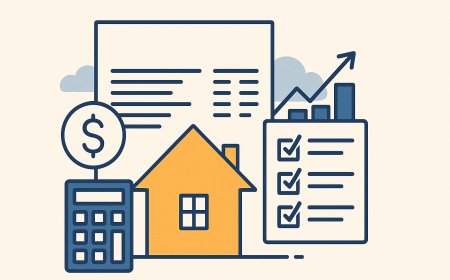Bank Statement Mortgage Loans in 2026: A Complete Guide for Self-Employed & Gig Workers in the U.S.
Learn how bank statement mortgage loans work in 2026 for self-employed, freelancers, and gig-economy workers. Includes requirements, income rules, and approval steps.

Securing a mortgage has traditionally required W-2 income, predictable earnings, and complete tax documentation. In 2026, a growing number of U.S. borrowers operate outside that structure. Self-employed professionals, freelancers, contractors, and gig-economy workers often rely on variable income, business expenses, and tax write-offs—which can make qualifying through conventional underwriting challenging.
Bank statement mortgage loans have emerged as a practical alternative. These programs evaluate income through 12–24 months of bank statements, making them suited for borrowers with non-traditional earnings. This guide explains how these loans work in 2026, the eligibility process, common approval challenges, and how self-employed applicants can navigate requirements effectively.
1. Why Many Borrowers Struggle With Traditional Mortgages in 2026
Traditional mortgage approval relies on tax returns, pay stubs, and W-2s to determine stable qualifying income. For many independent workers in 2026, these documents don’t reflect true earnings. Factors include:
- Fluctuating or seasonal income
- Substantial business deductions reducing taxable income
- Multiple income sources across platforms or clients
- Limited W-2 documentation
For these scenarios, bank statement loans use cash flow evidence rather than standard tax documentation, offering a more accurate representation of income for many modern workers.
Borrowers can explore standard loan types for comparison, such as Conventional Loans or FHA Loans, but alternative documentation may be more suitable for those with variable or self-generated earnings.
2. What Is a Bank Statement Mortgage Loan?
A bank statement mortgage loan uses personal or business bank statements to calculate qualifying income. Instead of tax returns, lenders review monthly deposits to assess cash flow and income stability.
Key characteristics in 2026
- 12 or 24 months of bank statements accepted
- Personal or business accounts can qualify
- Income often calculated using a percentage of average deposits
- Available for primary residences, second homes, and some investment properties
- Falls under the category of non-QM (Non-Qualified Mortgage) loans
Borrowers can review specific program details at: Bank Statement Loans in Columbus, OH
3. Who Bank Statement Loans Are Designed For
Bank statement loans align with the needs of borrowers who generate income from non-W-2 sources. In 2026, typical applicants include:
Self-Employed Individuals
- Consultants, designers, contractors, IT specialists
- Small business owners with fluctuating revenue
- Entrepreneurs with inconsistent monthly payouts
Freelancers & Independent Contractors
- Digital creators, writers, marketers, engineers
- Skilled tradespeople working per-project
Gig-Economy Workers and 1099 Earners
- Rideshare drivers
- Delivery drivers
- On-demand service providers
- Task-based labor platforms
Online Sellers and Service Providers
- E-commerce sellers
- Subscription-based business operators
- Remote freelancers with global income streams
These groups commonly face income-verification obstacles with traditional loan programs, making alternative documentation a more practical path to financing.
4. How Bank Statement Mortgages Work in 2026
A. Income Analysis
Lenders review deposits across a 12–24-month period. Typical income evaluation can include:
- Average monthly deposits
- Expense factor adjustments (especially for business accounts)
- Consistency and stability of deposits
- Verification of income sources
Personal statements may use full deposits, while business statements often apply an expense ratio—commonly 50–70% depending on the industry.
B. Documentation Requirements
While tax returns are not required, other documents may include:
- Bank statements (12–24 months)
- Proof of business ownership (self-employed)
- Year-to-date profit and loss (in some cases)
- Identification and residency documentation
C. Loan Terms in 2026
Terms can vary by lender, but typical elements include:
- Down payments often starting at 10–20%
- Credit score requirements generally above 600–620
- Debt-to-income (DTI) flexibility compared with traditional mortgages
- Loan amounts available up to high-balance tiers
Borrowers comparing loan payment expectations can use the Mortgage Payment Calculator for general planning.
5. 12-Month vs. 24-Month Bank Statement Options
Both options remain widely available in 2026:
12-Month Program
- Faster qualification window
- Higher minimum credit scores
- Useful for borrowers with increasing income trends
24-Month Program
- Smoother income average
- May allow for more flexible guidelines
- Suitable for businesses with seasonal or variable income
The choice typically depends on deposit patterns and financial stability.
6. Requirements for Bank Statement Mortgage Approval (2026)
Primary Approval Factors
- Consistent deposits showing stable income
- Clean bank records (limited overdrafts, NSF occurrences)
- Reasonable expense ratios for business accounts
- Adequate reserves post-closing (varies by loan size)
- Acceptable DTI ratio based on income calculations
- Clear documentation of self-employment
Borrowers can examine general purchase requirements using: Purchase Form - The Ultimate Mortgage
7. Common Challenges and How to Avoid Them
A. Irregular or unexplained deposits
Lenders need clear documentation for large or inconsistent amounts.
B. Mixing business and personal funds
Separate accounts help simplify income verification.
C. Overdrafts or insufficient funds
Frequent overdrafts may indicate financial instability.
D. Lack of documentation confirming self-employment
This may include business licenses, contracts, invoices, or website presence.
E. Significant cash deposits without traceable origins
These typically cannot be used for income calculations.
Addressing these issues prior to application improves the likelihood of approval.
8. Preparing Bank Statements for Fast Approval in 2026
Borrowers can take steps to strengthen their financial profile:
- Review statements for deposit consistency and patterns
- Minimize unnecessary transfers between accounts
- Maintain clear records of client payments
- Separate business and personal deposits
- Reduce irregular cash deposits
- Ensure NSF or overdraft activity is limited or absent
- Maintain reserves for emergencies or closing costs
Borrowers exploring financing alternatives can also compare other loan types such as VA Loans.
9. Gig-Economy Workers: Special Considerations
In 2026, gig-economy workers increasingly rely on multiple income sources across platforms. Lenders may review:
- Ride-share income patterns
- Delivery service deposits
- Multiple 1099 forms
- Platform-generated earnings reports
- Seasonal fluctuations
Bank statement lending can better reflect these realities, as it evaluates net inflows rather than standardized employer documentation.
10. Self-Employed Borrowers: Key Considerations
Self-employed borrowers often experience:
- Volatile revenue cycles
- Deductible operating expenses
- Multiple income streams
- Business reinvestment patterns
Because tax returns reflect net income after deductions, bank statements offer a more accurate picture of cash-flow-based income.
Borrowers seeking to evaluate buying power can use the Affordability Calculator as a planning tool.
11. Example Scenario (2026 Case Study)
A freelancer with a mix of digital marketing income, contract work, and part-time delivery driving applies for a loan. Their tax return shows low net income due to business deductions.
Through a 24-month personal bank statement review, the lender calculates average deposits that reflect stable earnings.
The borrower meets DTI requirements, maintains a consistent deposit history, and shows no significant overdraft activity.
Under a bank statement program, income is accepted based on verifiable cash flow rather than adjusted gross income, resulting in a successful qualification scenario.
12. FAQs (2026)
Can bank statement loans be used without tax returns in 2026?
Yes. Income verification is based primarily on bank deposit history.
Are business bank statements acceptable?
Yes, but expense factors may apply to account for operational costs.
Do gig-economy workers qualify?
Deposits from rideshare, delivery, or freelance platforms may be used if verifiable.
Can investment properties be financed with bank statement loans?
Some programs allow it, though requirements may differ.
Do bank statement loans require more reserves?
Reserve requirements depend on loan size and risk assessment.
Conclusion
Bank statement mortgage loans provide an alternative path for self-employed individuals, freelancers, gig workers, and independent professionals navigating non-traditional income structures in 2026. The approach offers flexibility where standard documentation falls short, focusing on financial behavior reflected through bank activity rather than conventional tax metrics. For borrowers seeking to understand their financing options, reviewing loan programs, planning tools, and available resources can help clarify the most suitable approach.













































